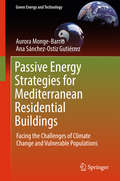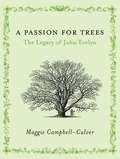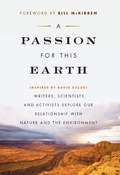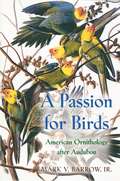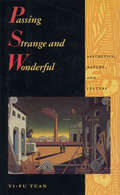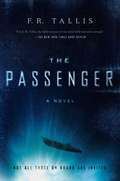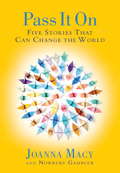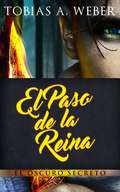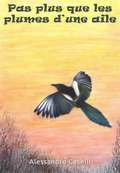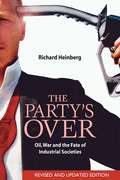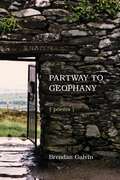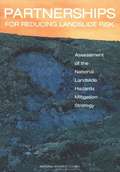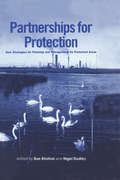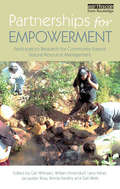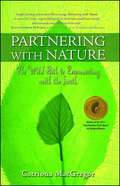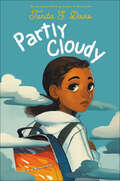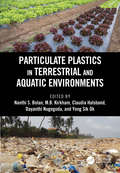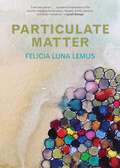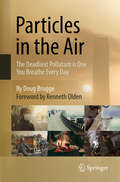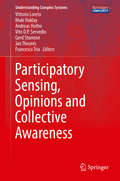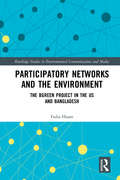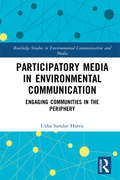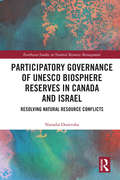- Table View
- List View
Passive Energy Strategies for Mediterranean Residential Buildings
by Aurora Monge-Barrio Ana Sánchez-Ostiz GutiérrezThis book presents an approach to energy-efficient building design, which takes into account the most important challenges in climate change mitigation and adaptation in Southern Europe. It outlines a specific approach related to residential buildings and their intergenerational and vulnerable occupants, such as ageing population and users in fuel poverty. It also focuses on the use of passive energy measures throughout the year, and on pursuing a realistic and affordable approach to the efficient rehabilitation of resilient residential buildings.In addition, the book presents case studies that include surveys, monitoring, and simulation of residential buildings in Spain and other Southern European representative locations, in order to go further on the study of this challenging topic.
A Passion For Trees: The Legacy Of John Evelyn
by Maggie Campbell-CulverGiven the extent of his influence on 17th-century life, and his lasting impact on the British landscape it is remarkable that no book has been written before about John Evelyn. He was a longstanding friend of Samuel Pepys (who wrote of him, ' A most excellent person he is, and must be allowed a little for conceitedness; but he may well be so, being a man so much above others.'), a founder-member of the Royal Society and a prolific writer and diarist. He was an early advocate of the garden city but his most important work was Sylva: a Discourse of Forest Trees. Sylva was presented to the Royal Society to promote the planting of timber trees 'for the supply of the Navy, the employment and advantage of the poor as well as the ornamenting of the nation.' He was responsible for the first great raft of tree-planting and for a great influx of tree introductions to Britain.Maggie Campbell-Culver's book, like Sylva, has at its core a section detailing the characteristics, history and uses of 33 trees incorporating the advice Evelyn gave and demonstrating its relevance still in the 20th-century. Not only was Evelyn probably the first horticultural writer to show an appreciation of the aesthetic benefits of trees in our landscape, he is shown to be a founder-father of the modern conservation movement.
A Passion for This Earth: Writers, Scientists, and Activists Explore Our Relationship with Nature and the Environment
by Alan Weisman Michelle Benjamin Rick Bass Richard Mabey Helen CaldicottDavid Suzuki's lifelong work as an environmentalist, naturalist, and scientist have influenced countless others in their fight to save the planet, 20 such devotees of them have contributed to this inspiring collection. <P><P>These journalists, scientists, writers and environmentalists have taken their enthusiasm for Suzuki's philosophy and funneled it into their own personal recollections, manifestos, and essays: Rick Bass describes his love for the Yaak Valley in Montana; Richard Mabey takes readers to a moonlit May evening in Suffolk; David Helvarg tells us of a stirring seaside memory from his childhood. No matter what journey these writers take us on, the unifying theme of their work is always the same: a deep and abiding love of nature - inspired and shared by David Suzuki.
A Passion for Birds: American Ornithology after Audubon
by Mark BarrowIn the decades following the Civil War--as industrialization, urbanization, and economic expansion increasingly reshaped the landscape--many Americans began seeking adventure and aesthetic gratification through avian pursuits. By the turn of the century, hundreds of thousands of middle-and upper-class devotees were rushing to join Audubon societies, purchase field guides, and keep records of the species they encountered in the wild. Mark Barrow vividly reconstructs this story not only through the experiences of birdwatchers, collectors, conservationists, and taxidermists, but also through those of a relatively new breed of bird enthusiast: the technically oriented ornithologist. In exploring how ornithologists struggled to forge a discipline and profession amidst an explosion of popular interest in natural history, A Passion for Birds provides the first book-length history of American ornithology from the death of John James Audubon to the Second World War. Barrow shows how efforts to form a scientific community distinct from popular birders met with only partial success. The founding of the American Ornithologists' Union in 1883 and the subsequent expansion of formal educational and employment opportunities in ornithology marked important milestones in this campaign. Yet by the middle of the twentieth century, when ornithology had finally achieved the status of a modern profession, its practitioners remained dependent on the services of birdwatchers and other amateur enthusiasts. Environmental issues also loom large in Barrow's account as he traces areas of both cooperation and conflict between ornithologists and wildlife conservationists. Recounting a colorful story based on the interactions among a wide variety of bird-lovers, this book will interest historians of science, environmental historians, ornithologists, birdwatchers, and anyone curious about the historical roots of today's birding boom.
Passing Strange and Wonderful: Aesthetics Nature And Culture
by Yi-Fu TuanIn this rich and rewarding work, Yi-Fu Tuan vividly demonstrates that feeling and beauty are essential components of life and society. The aesthetic is not merely one aspect of culture but its central core -- both its driving force and its ultimate goal.Beginning with the individual and his physical world, Tuan's exploration progresses from the simple to the complex. His initial evaluation of the building blocks of aesthetic experience (sight, hearing, smell, taste, touch) develops gradually into a wide-ranging examination of the most elaborate of human constructs, including art, architecture, literature, philosophy, music, and more.
The Passenger: A Novel
by F. R. TallisThe new supernatural thriller from F. R. Tallis, who takes his readers under the wartime seas of the stormy North Atlantic in 1942, where not all those on board are invited . . . A German submarine, U-330, patrols the stormy inhospitable waters of the North Atlantic. It is commanded by Siegfried Lorenz, a maverick SS officer who does not believe in the war he is bound by duty and honor to fight in. U-330 receives a triple-encoded message with instructions to collect two prisoners from a vessel located off the Icelandic coast and transport them to the base at Brest—and a British submarine commander, Sutherland, and a Norwegian academic, Professor Bjornar Grimstad, are taken on board. Contact between the prisoners and Lorenz has been forbidden, and it transpires that this special mission has been ordered by an unknown source, high up in the SS. It is rumored that Grimstad is working on a secret weapon that could change the course of the war . . . Then, Sutherland goes rogue, and a series of shocking, brutal events occur. In the aftermath, disturbing things start happening on the boat. It seems that a lethal, supernatural force is stalking the crew, wrestling with Lorenz for control. A thousand feet under the dark, icy waves, it doesn't matter how loud you scream...
Passage to Mutiny (Richard Bolitho Ser. #7)
by Alexander KentIn 1789 Captain Richard Bolitho is aboard the frigate Tempest in the South Pacific, where he is to protect English shipping lanes from seagoing enemies. At the same time he must contain a growing mutiny aboard his own ship. Sequel to Command a King's Ship, 1976.
Pass it On: Five Stories That Can Change the World
by Joanna Macy Norbert GahblerEco-philosopher and best-selling author Joanna Macy, Ph.D., shares five stories from her more than thirty years of studying and practicing Buddhism and deep ecology. Gathered on her travels to India, Russia, Australia, and Tibet, these stories give testament to Joanna Macy's belief that either humankind awakens to a new and deeper understanding of our interconnectedness with our planet and all its myriad forms of life or risks loosing it. To bring about such a transformation of consciousness each and every one of us counts. Five Stories that Can Change the World tells of encounters with individuals who share very personal stories of sudden awakening, unexpected awareness, and the co-mingling of joy and pain. Each story is imbued with the specific cultural flavor of the places where the stories originate, but all share that each individual counts in the global need for change and awakening.Pas It On provides an introduction to Joanna Macy's work of "deep ecology" and "the great turning" and the deep interconnected nature of all beings.Introduction by Norbert Gahbler.
Pass it On
by Joanna Macy Norbert GahblerEco-philosopher and best-selling author Joanna Macy shares five stories from her more than 30 years of studying and practicing Buddhism and deep ecology. Gathered on her travels to India, Russia, Australia, and Tibet, these stories testify to Joanna Macy's belief that either humankind awakens to a new and deeper understanding of our interconnectedness with its planet or risks loosing it. Pass it On tells of encounters with individuals who share very personal stories of sudden awakening, unexpected awareness, and the co-mingling of joy and pain. Each story is imbued with the specific cultural flavor of the places where the stories originate, but all show how each individual counts in the global need for change and awakening.
El Paso de la Reina - El Oscuro Secreto
by Tobias A. WeberTodos pensaban que los Inmortales habían destruído a los Magos años atrás, pero esto parecía ser una desilución mortal. No siendo los únicos en querer destruir el Reino de Ver El mismo día que la magia regresa al mundo, un vieje enemigo aparece. Con el mundo en caída hacia el caos, los paladines Bren y Laris son enviados en una misión para traer luces al asunto. Pero la gran sombra de una antigua era llena de secretos está sobre ellos, y pronto se enfrentarán no solamente por la libertad del Reino, sino por las vidas de todos aquellos a quienes ellos aprecian.
Pas plus que les plumes d'une aile
by Alessandro CaselliThief est une jeune pie qui décide de ne pas quitter le nid car trop attachée à ses murs et à tous les objets qu’il renferme. Mais tous ces objets pèseront aussi sur sa vie, au point de l'obliger à faire un choix drastique : continuer de mener une existence solitaire et esclave de ses désirs ou bien changer de direction et affronter une vie peut-être tout aussi solitaire, mais libérée des chaînes avec lesquelles Thief s’était elle-même liée à ses « trésors ».
The Party's Over
by Richard HeinbergThe world is about to run out of cheap oil and change dramatically. Within the next few years, global production will peak. Thereafter, even if industrial societies begin to switch to alternative energy sources, they will have less net energy each year to do all the work essential to the survival of complex societies. We are entering a new era, as different from the industrial era as the latter was from medieval times. In The Party's Over, Richard Heinberg places this momentous transition in historical context, showing how industrialism arose from the harnessing of fossil fuels, how competition to control access to oil shaped the geopolitics of the twentieth century and how contention for dwindling energy resources in the twenty-first century will lead to resource wars in the Middle East, Central Asia and South America. He describes the likely impacts of oil depletion and all of the energy alternatives. Predicting chaos unless the United States--the world's foremost oil consumer--is willing to join with other countries to implement a global program of resource conservation and sharing, he also recommends a "managed collapse" that might make way for a slower-paced, low-energy, sustainable society in the future. More readable than other accounts of this issue, with fuller discussion of the context, social implications and recommendations for personal, community, national and global action, Heinberg's updated book is a riveting wake-up call for human-kind as the oil era winds down, and a critical tool for understanding and influencing current US foreign policy.
Partway to Geophany: Poems
by Brendan GalvinPartway to Geophany, the latest collection by celebrated poet Brendan Galvin, chronicles the waxing and waning of the year in a small seacoast town on Cape Cod, alongside observations of other beloved places. As a naturalist and environmentalist, Galvin undertakes poems that meditate on wildlife, landscape, and the passage of time. His verse presents powerful and immediate detailings of quotidian experience, with poems about love and loss, local people and customs, foreign and domestic travel, and writing itself. Throughout, Galvin probes the implied question, What is humanity’s place in the natural world? His masterful use of the narrative lyric produces poems of great mystery and intimacy, in tones varying from grave to playful, as he reflects on the cruelties of time and the pleasures of being alive.
Partnerships For Reducing Landslide Risk: Assessment of the National Landslide Hazards Mitigation Strategy
by Committee on the Review of the National Landslide Hazards Mitigation StrategyLandslides occur in all geographic regions of the nation in response to a wide range of conditions and triggering processes that include storms, earthquakes, and human activities. Landslides in the United States result in an estimated average of 25 to 50 deaths annually and cost $1 to 3 billion per year. In addition to direct losses, landslides also cause significant environmental damage and societal disruption. This report reviews the U.S. Geological Survey’s (USGS) National Landslide Hazards Mitigation Strategy, which was created in response to a congressional directive for a national approach to reducing losses from landslides. Components of the strategy include basic research activities, improved public policy measures, and enhanced mitigation of landslides.The NRC report commends the USGS for creating a national approach based on partnerships with federal, state, local, and non-governmental entities, and finds that the plan components are the essential elements of a national strategy. The report recommends that the plan should promote the use of risk analysis techniques, and should play a vital role in evaluating methods, setting standards, and advancing procedures and guidelines for landslide hazard maps and assessments. The NRC panel suggests that substantially increased funding will be required to implement a national landslide mitigation program, and that as part of a 10-year program the funding mix should transition from research and guideline development to partnership-based implementation of loss reduction measures.
Partnerships for Protection: New Strategies for Planning and Management for Protected Areas
by Sue Stolton Nigel Dudley Biksham Gujja Bill Jackson Jean-Paul Jeanrenaud Gonzalo Oviedo Pedro Rosabal Adrian Phillips Sue WellsTaking into consideration the fact that many ecosystems are under-represented in protected areas of land and water and traditional management methods have often been ineffective, this volume describes how improvements can be made. Specifically, it explores ways of ensuring that all major ecosystems are safeguarded, and innovative approaches to conservation involving individuals, communities, companies and governments. The essence of the approach taken in the text is to build partnerships with those who have a stake in the care of land and water resources.
Partnerships for Empowerment: Participatory Research for Community-based Natural Resource Management
by Carl Wilmsen William Elmendorf Larry Fisher Jacquelyn Ross Brinda Sarathy Gail WellsParticipatory research has emerged as an approach to producing knowledge that is sufficiently grounded in local needs and realities to support community-based natural resource management (CBNRM), and it is often touted as crucial to the sustainable management of forests and other natural resources. This book analyses the current state of the art of participatory research in CBNRM. Its chapters and case studies examine recent experiences in collaborative forest management, harvesting impacts on forest shrubs, watershed restoration in Native American communities, civic environmentalism in an urban neighborhood and other topics. Although the main geographic focus of the book is the United States, the issues raised are synthesized and discussed in the context of recent critiques of participatory research and CBNRM worldwide. The book's purpose is to provide insights and lessons for academics and practitioners involved in CBNRM in many contexts. The issues it covers will be relevant to participatory research and CBNRM practitioners and students the world over.
Partnering with Nature: The Wild Path to Reconnecting with the Earth
by Catriona MacgregorPartnering with Nature is a simple book with a powerful message: our connections to the natural environment-- and ultimately, to ourselves--are crucial in today's fragmented world. As each successive generation moves farther away from nature, the growing disconnect is expressed through physical as well as mental stress, from depression and fatigue in adults to attention disorders and obesity in children. The way we relate to nature helps define our place within it, and by awakening this natural, yet dormant connection to the environment around us, we can move beyond solitary stewardship and into partnership.In Partnering with Nature, Catriona MacGregor weaves together scientific and historical wisdom, spiritual insights, and inspiring stories that illuminate the energies that link humans, animals, and the natural world. Through observation and conscious practice, we can open up to the power of nature to transform our lives, uplift our spirits, and even to direct our bodies to a healthier potential. For everyone who has a sense of something missing, who wishes to make a difference in their world, who yearns to reclaim their sense of wonder and awe, or who struggles with their health or emotional balance--nature speaks to all who will listen.
Partly Cloudy
by Tanita S. DavisFrom award-winning author Tanita S. Davis comes a nuanced exploration of the microaggressions of middle school and a young Black girl named Madalyn who learns that being a good friend means dealing with the blue skies and the rain—and having the tough conversations on days that are partly cloudy. Perfect for fans of A Good Kind of Trouble and From the Desk of Zoe Washington.Lightning couldn’t strike twice, could it? After a terrible year, Madalyn needs clear skies desperately. Moving in with her great-uncle, Papa Lobo, and switching to a new school is just the first step.It’s not all rainbows and sunshine, though. Madalyn discovers she’s the only Black girl in her class, and while most of her classmates are friendly, assumptions lead to some serious storms.Papa Lobo’s long-running feud with neighbor Mrs. Baylor brings wild weather of its own, and Madalyn wonders just how far things will go. But when fire threatens the community, Madalyn discovers that truly being neighborly means more than just staying on your side of the street— it means weathering tough conversations—and finding that together a family can pull through anything.Award-winning author Tanita S. Davis shows us that life isn’t always clear, and that partly cloudy days still contain a bit of blue worth celebrating.
Particulate Plastics in Terrestrial and Aquatic Environments
by Nanthi S. Bolan, M.B. Kirkham, Claudia Halsband, Dayanthi Nugegoda, Yong Sik OkThe manufacture of plastic as well as its indiscriminate disposal and destruction by incineration pollutes atmospheric, terrestrial, and aquatic ecosystems. Synthetic plastics do not break down; they accumulate in the environment as macro-, micro-, and nanoplastics. These particulate plastics are a major source of pollutants in soil and marine ecosystems. Particulate Plastics in Terrestrial and Aquatic Environments provides a fundamental understanding of the sources of these plastics and the threats they pose to the environment. The book demonstrates the ecotoxicity of particulate plastics using case studies and offers management practices to mitigate particulate plastic contamination in the environment. Features · Describes physical and chemical properties of particulate plastics in terrestrial and aquatic ecosystems · Presents information on characteristics of particulate plastics as impacted by weathering processes · Provides numerous approaches for managing particulate plastic contamination · Identifies sources of particulate plastics in the environment; distribution and characteristics of particulate plastics; and management strategies of particulate plastics Written by a global team of scientists, this book is for researchers in the fields of environmental safety and waste management or individuals interested in the impact of particulate plastics on environmental health.
Particulate Matter
by Felicia Luna LemusIn concise and distilled prose, Lemus presents a collection of still lifes, landscapes, and portraits of a challenging year that threatened all she loved most. "There are only a few words per page in Particulate Matter, but that
Particles in the Air: The Deadliest Pollutant is One You Breathe Every Day
by Doug BruggeThe book covers the three largest sources of particulate matter pollution in five chapters. These sources constitute three of the top ten public health problems in the world today and far outstrip any other environmental health threats in terms of health impact. The book begins with indoor solid fuel combustion for cooking in lower income countries and tells the story of how this problem was identified and recent efforts to eliminate it. The book next looks at tobacco smoking and second hand smoke, again reviewing the history of how these problems were identified scientifically and the fierce industry push back against the science. The last two chapters cover ambient particulate matter in the outdoor air. They address fine and ultrafine particles, describing the pioneering work on fine PM, the subsequent industry attacks on the scientists and then the emerging interest and concern about ultrafine particles, an area of research in which the author has participated. This book is geared towards non-scientists, including high school and college students.
Participatory Sensing, Opinions and Collective Awareness
by Francesca Tria Jan Theunis Gerd Stumme Vito D. P. Servedio Andreas Hotho Muki Haklay Vittorio LoretoThis book introduces and reviews recent advances inthe field in a comprehensive and non-technical way by focusing on the potentialof emerging citizen-science and social-computation frameworks, coupled with thelatest theoretical and modeling tools developed by physicists, mathematicians,computer and social scientists to analyse, interpret and visualize complex datasets. There is overwhelming evidence that the currentorganisation of our economies and societies is seriously damaging biologicalecosystems and human living conditions in the short term, with potentiallycatastrophic effects in the long term. The need to re-organise the dailyactivities with the greatest impact - energy consumption, transport, housing -towards a more efficient and sustainable development model has recently beenraised in the public debate on several global, environmental issues. Above all,this requires the mismatch between global, societal and individual needs to beaddressed. Recent advances in Information and Communication Technologies (ICT)can trigger important transitions at the individual and collective level toachieve this aim. Based on the findings of the collaborative researchnetwork EveryAware the following developments among the emerging ICTtechnologies are discussed in depth in this volume: * Participatory sensing - where ICT development ispushed to the level where it can supportinformed action at the hyperlocal scale, providing capabilities forenvironmental monitoring, data aggregation and mining, as well as informationpresentation and sharing. * Web gaming, social computing and internet-mediatedcollaboration - where the Web will continue to acquire the status of aninfrastructure for social computing, allowing users' cognitive abilities to becoordinated in online communities, and steering the collective action towardspredefined goals. * Collective awareness and decision-making - where theaccess to both personal and community data, collected by users, processed withsuitable analysis tools, and re-presented in an appropriate format by usablecommunication interfaces leads to a bottom-up development of collective socialstrategies.
Participatory Networks and the Environment: The BGreen Project in the US and Bangladesh (Routledge Studies in Environmental Communication and Media)
by Fadia HasanSeeking innovative answers to global sustainability challenges has become an urgent need with the onslaught of environmental and ecological degradation that surrounds us today. More than ever, there is a need to carve new ways for citizens and different industries and institutions to unite – to cooperate, communicate and collaborate to address growing global sustainability concerns. This book examines one such global collaboration called The BGreen Project (BGreen): a transnational participatory action research project that spans the United States and Bangladesh with the aim of addressing environmental issues via academic–community engagement. By analysing and unpacking the architecture of BGreen, Hasan teases out the key factors that are required for the continued momentum of environmentally focused, academic–community partnership projects in order to present a workable model that could be applied elsewhere. This model is based around a unique conceptual framework developed by the author – “transnational participatory networks” – which is drawn from participatory action research and actor network theory, with the specific aim of addressing the common challenge of building evolving, stable and sustainable networks. This book will be of great interest to students and scholars of environmental communication, citizen participation, environmental politics, environmental sociology and sustainable development.
Participatory Media in Environmental Communication: Engaging Communities in the Periphery (Routledge Studies in Environmental Communication and Media)
by Usha Sundar HarrisParticipatory Media in Environmental Communication brings together stories of communities in the Pacific islands – a region that is severely affected by the impacts of climate change. Despite living on the margins of the digital revolution, these island communities have used media and communication to create awareness of and find solutions to environmental challenges. By telling their stories in their own way, ordinary people are able to communicate compelling accounts of how different, but interrelated, environmental, political, and economic issues converge and impact at a local level. This book fills a significant gap in our understanding of how participatory media is used as a dialogic tool to raise awareness and facilitate discussion of environmental issues that are now critical. It includes a section on pedagogy and practice – the undergirding principles, the tools, the methods. The book offers a framework for Participatory Environmental Communication that weaves three widely used concepts, diversity, network and agency, into a cohesive underlying system to bring scholars, practitioners and diverse communities together in a dialogue about pressing environmental issues. This book is a valuable resource for researchers and students in communication and media studies, environmental communication, cultural studies, and environmental sciences, as well as practitioners, policy makers and environmental activists.
Participatory Governance of UNESCO Biosphere Reserves in Canada and Israel: Resolving Natural Resource Conflicts (Earthscan Studies in Natural Resource Management)
by Natasha DonevskaThis book explores how participatory governance processes help to find integrated solutions to resource-based development while protecting ecosystems in UNESCO designated areas. Participatory Governance of UNESCO Biosphere Reserves in Canada and Israel explores how stakeholders’ participation in decision-making processes related to natural resource management facilitates or hinders the obtainment of an acceptable balance between nature protection and sustainable development policies in the eyes of the participating stakeholders. A comparative analysis of nature versus development conflicts in the Megiddo and Mount Carmel biosphere reserves in Israel and the Mount Arrowsmith and Clayoquot Sound biosphere reserves in Canada, showcases the different approaches in implementing the biosphere reserve concept. The participatory processes of stakeholders, including governments, resource-based industries, local and indigenous communities and environmental NGOs established to address the local natural resource use problems are considered to be an opportunity of reconciliation among stakeholders with diverse interests, lifestyles and cultures but also improving the relationship between man and nature. Yet, achievement of these goals has proven to be a challenge. In some cases the participatory decision-making process yields benefits and in some cases it fails to deliver expected results. This book explores why is that the case. This title will be of great interest to students and scholars of natural resource management, integrated approaches to conservation and sustainable development, and participatory governance of social-ecological systems. It will also be of interest to environmental conflict mediators, participatory process facilitators, policymakers and professionals involved in managing social-ecological systems or establishing biosphere reserves.
